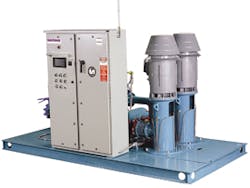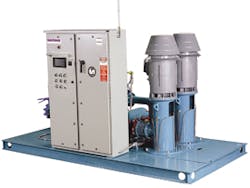Every day, Americans pump and pipe seven billion gallons of water outdoors, most of it to moisten our plants and lawns. Volume-wise, that equals a lake of about 450 acres, 50 feet deep–potable water pouring forth every single day from our taps. Of this amount, “as much as half is wasted,” declares the EPA, in its WaterSense Draft Specification for Weather-Based Irrigation Controllers for 2009.
For irrigators, residential and commercial, the challenge is to stop wasting so much. Toward this end, EPA asserts that weather-based controllers could save at least 20%. An industry Web site agrees that “smart” devices might save a much higher sum, nearly “Twenty-four billion gallons of water per year across the USA….” That’s the same lake–upsized seventeenfold. (Note: EPA’s text cites contradictory daily wastage figures of 1.5 versus nearly 3.5 billion gallons; perhaps industry and government should get together on their numbers!)
Moreover, the Smart Water Application Technologies (SWAT) Web site states that, “An average household replacing a conventional irrigation timer with a smart irrigation controller can save more than 10,000 gallons of water annually.” At two dollars or so per hundred cubic feet, that’s about $31 a year saved. With the cost of a controller at about $470, payback comes in 15 years, says EPA.
As for market-penetration of all home irrigation systems, EPA counts 13.5 million of them, keeping lawns green. The great majority is not “smart,” but they turn water on or off with crudely wasteful timers, sprinkling “mindlessly” even during rain. Hence, 95% of systems “are candidates for replacement,” says EPA. The smart technology of choice would typically be climate-based evapotranspiration-activated (CBET) controllers, now in use on fewer than 10% of all systems.
Vying for Control: CBET Versus SMSB
Within the industry itself, the big irrigation debate for some years has been: Which controller brands give the best results. There’s also a “turf war” between two fundamentally different automation technologies. The current leader is CBET, but this device is looking anxiously over its shoulder at a slick challenger–soil moisture sensor-based (SMSB) systems.
Which works best? SWAT product testing began in 2005. To date, several dozen CBET controllers from 14 manufacturers have been put through their paces; see results at http://irrigation.org/SWAT/swat.aspx?id=298. Testers only examine smaller irrigation systems, not industrial-sized ones, but the core technologies are often similar, large or small.
CBET brands examined by SWAT so far include: Alex-Tronix Enercon (two models); Aqua Conserve (four ET series models); Calsense (all); Cyber-Rain XCI; Hunter Industries Solar Sync (with controller); Hydropoint WeatherTRAK ET Plus (four models); Hydrodsaver ETIC 24; Irritrol Smart Dial (nine models); Rain Bird ET Manager (with controller); ESP-SMT; Rain Master Eagle; SMG Superior Controls Sterling Series (all models); Toro Intelli-Sense (two models); and Weathermatic Smartline SL 1600 (four models).
What about SMSB controllers? Testing is just getting underway, and so far only three brands have undergone first-stage calibration–Acclima, Decagon, and Irrometer Watermark.
Which technology wins? Latest results seem to give SMSB the edge. One indication came in head-to-head multiple-system testing that SWAT conducted in three California cities recently. Water savings in Santa Barbara, using CBET, averaged 26%, with some sites getting as high as 59%; and in Irvine, 16%, with a high of 24%. But topping the norms, if not the peaks, the SMSB-controlled systems, installed in Moreno, hit an average of 35%.
SWAT is also testing or planning to test related irrigation parts such as matching precipitation rate nozzles, flow control nozzles, rain shut-off devices, pressure regulators, multi-stream rotating nozzles, high flow shut-offs, and drip and micro-irrigation technologies.
Besides the industry’s effort, several firms have done evaluations of their own. Chris Wright, a water conservation advisor in the western US for Ewing Irrigation Products Inc., says he’s seen “hundreds of each” type of controller technology in his travels, as a field representative for this major distributor with 195 branches in 22 states. He has also cataloged a number problems, challenges, and outstanding successes that customers are having.
In general, he says the irrigation industry probably needs to do more on its methodology than on the technology, adding that “As industry knowledge and experience advances, the number of complaints are declining and acceptance is growing. We’re still on a learning curve on getting the contractors to learn how to change some of their [outmoded] practices in designing, installing, and maintaining systems that will give us the savings we’re looking for.” Three solid resources he recommends for contractor education are The Irrigation Association, the American Society of Irrigation Consultants, and EPA WaterSense.
How CBET controllers operate, technically speaking, is fairly straightforward. As the allusion to weather in the name suggests, current forecast data on moisture, temperature, etc., factor into deciding when water should turn on or off. The evapotranspiration (ET) element in the name refers to the rate at which soils will dry after a soaking, until more irrigation is needed. Precise ET rates vary according to things like plant-specific water uptake, ambient temperatures, wind, and humidity–hence the weather data linkage. In essence, then, a rain forecast triggers irrigation to shut down or delay, so sprinklers don’t double-dose lawns just as clouds are bursting.
SMSB, by contrast, use radically different measures. As the “soil moisture sensor” moniker suggests, sensors are actually placed in soil. Irrigation then turns on or off, according to a registered “moist” or “dry” signal sent via buried wires. Sensors measure actual moisture, notes Wright, “right at the root zone of the plants.” SMSB reads “the result of ET, and doesn’t really care about what’s going on environmentally, or soil types, or the slope or plant material,” he says.
For accuracy, SMSB sensors should be shoved into the ground at neither the driest nor wettest soil spots, but at points representing an overall moisture average. A single one should do for covering a dozen hydrozones or watering areas. Then comes a bit of setup calibration.
As for results: During this interview, Wright happened to be inspecting data on an outstanding SMSB success at Otay Ranch, near San Diego, CA. In 2009, two sensors had been positioned there, one in the turf zone and another amidst some shrubs. In the former, a timer-defined watering plan had scheduled 107 water days from April to September 2009, but after inserting moisture sensors, the automated controller decided to allow watering on just 43 days. In the shrub bed area, 95 watering days had been plotted by a timer, but the sensor overruled and permitted just 15. Result: “We estimated water savings were well over 60%,” in a very water-challenged region, he says, and plants and grass thrived.
SMSB, he concludes, “is fantastic technology. The science behind it has improved dramatically to the point where it’s highly reliable, repeatable, and sensitive enough to regulate needs of specific plant material.”
But, speaking in defense of CBET–and pointing out why this technology will likely continue to be indispensable for the foreseeable future–is Jason LaRiva. He’s a landscape maintenance specialist for the City of Santa Clarita, CA. In February 2010, LaRiva’s city department began phasing-in what is reportedly the largest “smart” water management system ever installed anywhere.
At such a scale, LaRiva says, SMSB “would just not be a feasible solution for us,” due to the huge chunks of real estate he’s maintaining–over 700 acres–“with varying landscape and slopes,” all over town. Hence, CBET is the only practical choice. One chief reason is that SMSB systems require hardwired communication, while CBET–basing its control decisions on dialed-in algorithms–does not. The SMSB wiring factor alone adds “a big obstacle” and future maintenance headaches, he believes.
“We often run into gophers and squirrels chewing through wires” in city land plots, says LaRiva, so the prospect of relying upon and servicing a technology vulnerable to burrowing critters and insects at scores of points around the city, was a non-starter.
Although wireless SMSB could overcome some of his objections, the added cost is currently prohibitive, he says. However, he thinks SMSB might make sense for a modest or compact project, such as a single park or golf course.
Whichever system you employ, “There’s a holistic approach that needs to be taken, that looks at the total efficiency of the system,” says Wright. “You can’t just put a smart controller on a “˜dumb’ system, and assume you’re going to have water savings. If you were under-watering previous to adding a controller, you may wind up using more water afterwards…. It happens all the time.”
Idaho Lawn Care Lab
Clyde Lingo, president of The Cutting Edge Lawn Company in Garden City, ID, had also entertained all the vendors’ claims and wondered which controllers work best and how well; so, six years ago, he started testing them independently. Since then, he’s tried out, he says, “dang near everything”–eight or so CBET controllers, pitted against a dozen SMSB products from three brands.
Results-wise, “Pretty much every product provides some water savings,” he says. But on the whole, manufacturers’ claims “don’t hold up” very well. With CBET in particular, average savings of 5% to 10% “are not enough” to make even a modest investment proposition attractive.
Lately though, he’s found one exceptional success–again, using SMSB technology: the Baseline Watertec 100m model, with which, he states, “we have as much as 50% documented savings.”
Earlier-generation SMSB had suffered “a number of pitfalls,” but this latest seems dramatically improved. Beginning this year he plans to start giving them away to lawn care clients, “to save them money, and save us time.” Each costs around $300, installed.
Overall, the biggest hurdle and complaint Lingo’s encountered with all controllers is that “most of them require a more complex agronomic background than most of contractors are used to…. People can’t work them, can’t program them, and don’t know how to water in the first place,” he says.
The solution is obviously “better product education on the front side, to teach the contractors and homeowner basic principles about watering, before you give them a product and get a high failure rate out of it,” he says.
Another suggestion is to do anything you can to simplify setup, bypassing the overly sophisticated features like auto-calibration. Novices find this intimidating. So, switch to manual control and keep it user-friendly.
As for reeducation about watering: Most people, he finds, are inclined to water frequently at shallow depth. This is pretty much opposite of what is desirable. Plant health and water efficiency result from longer watering, done less frequently. “Turf may struggle a bit for the first season as it builds a large-enough root system, but by the second, it should be fine,” he says.
Example one: A residential site that was being watered every three days in summer received an SMSB; it stretched the interval to five or six days and saved 55% on water use. Another: A downtown commercial site saw its water bill fall 49%–“a $1,196 savings on a $300 investment, in a nine-month watering season,” he says. “And the lawn was beautiful and green.”
John Fordemwalt, president of the Baseline Systems SMSB, which Lingo so favors, reports that his customers “typically see a one- to three-year break-even time,” i.e., investment payback, with savings of at least 30% and sometimes as high as 60% to 70% in wet climates–assuming correct installation and operation.
High-Performance Nozzles, Pumps
So much for controller contests.
Next, for pure efficiency, savings nearly as dramatic have been logged by a pair of irrigation spray nozzle innovations of late. Again, both designs achieve similar performance breakthroughs, yet arrive there using very different technologies.
In 2008, The Toro Company won Product of the Year honors at the Irrigation Show, for its Precision series nozzles. A few years before, Hunter Industries introduced its breakthrough product, the MP Rotator nozzle. With slick, compact new engineering, both are sending forth refined and tightly controlled sprinkler arcs, for efficiency savings of 30% to 35%.
In the Toro Precision plastic core, where once there sat curved angular surfaces to direct each spray like a carom shot, there now resides a device that does the same angular directing using rapid oscillation. This results in considerably “less friction loss in getting that stream to go a particular distance than if you have to ricochet water off of a plastic surface,” explains Toro’s national sales and specification manager for water management products, Mike Baron.
Combining several streams achieves the desired water footprint, at stepped distances from 5 to 15 feet, “with much greater precision” than before, he says–assuming the rest of the system is properly ordered.
Delivered water coverage is the same as with previous-generation nozzles, but accomplished with a 35% lower flow rate, without lengthening the run-times at all, he adds.
Another key to efficiency is the ability to mix rectangular 4×9 or 4×18 side-strips sprinklers together with matched circular sprayers–something not doable previously. Baron explains, “The big water-waster in our industry is when you combine [mismatched] sprinklers on the same valve, so, when the valve turns on, some sprinklers are putting water down at two inches per hour, but others at half an inch….”
Preceding Toro’s Precision series, the MP Rotator was developed in 2002, by Walla Walla Sprinkler Company (now under Nelson Irrigation, in the agricultural supply field). Nelson realized the enormous improvement gained with the Walla Walla nozzle’s 0.39-inches-per-hour application rate, compared to competitors’ 1.6-inches-per- hour. The design accomplishes this with a rotating head and multiple streams over a larger footprint–“sprinkling,” says Baron, “instead of “˜hammering’ the ground, with resulting loss from compaction and runoff.”
Hunter acquired the Nelson nozzle in mid-2007 and relaunched it as the MP Rotator, for landscape irrigation. It’s now saving 30% on water, verified by the Center for Irrigation Technology. It’s also the first nozzle to qualify for a number of rebates, now offered in half a dozen states and counting. Qualifying nozzles are list-priced in the $4 to $10 range, and they install on existing popular heads, says Baron. Contractors who do this work will also fix leaks, replace seals, and do other repairs, thereby helping to justify the labor expense. Adding a pressure regulator at the spray head is also necessary for maximum efficiency, he advises.
Rain Bird, another major manufacturer, has also introduced a rotary nozzle as the newest addition to its efficiency line.
Back in Idaho, Lingo uses rotary nozzles and finds. “They’ve increased the uniformity to all of our sprinkler system coverages … documented at 97%…. They put out about a fifth of the water of comparable heads to cover the same area; it’s an incredible product.” Also, his cost of installation for a new irrigation system has declined, because the skimpy water usage allows him to scale-down every component, from valves to piping and the number of stations.
Supporting such components in industrial-scale irrigation, you can also add water and energy-efficient pump controls, notes Boyd Rose, business manager for irrigation at ITT Flowtronex, makers of a new pump called the Nexus. Greater efficiency and ease-of-use are attained with automation to turn on and off and adjust speed, via Web-based access. Another key feature, says Rose, is tight integration with the CBET controller, as the Nexus product does with Toro’s Lynx.
If energy conservation is the critical factor, a system operator “can program his irrigation, based on power consumption reduction, instead of how much water he needs…. Over time, he can prioritize by how much power he’s going to use to deliver his water,” says Rose. So it’s a whole new paradigm…. No one has ever had that before.”
Final thoughts from Wright: “…These technologies are not going to go away. They’re very much here to stay and will continue to be improved upon. The sooner irrigation or landscape maintenance contractors or municipalities are willing to embrace them, the sooner we’ll be able to see the results, in terms of conservation.”



